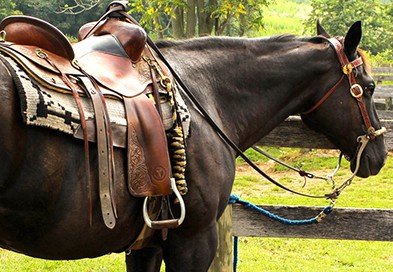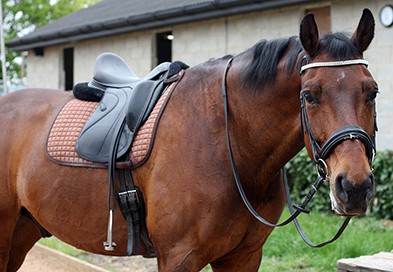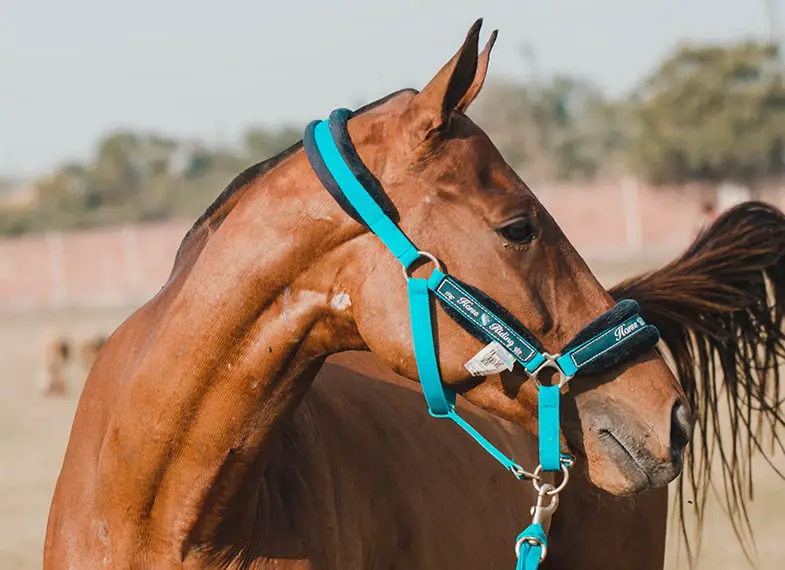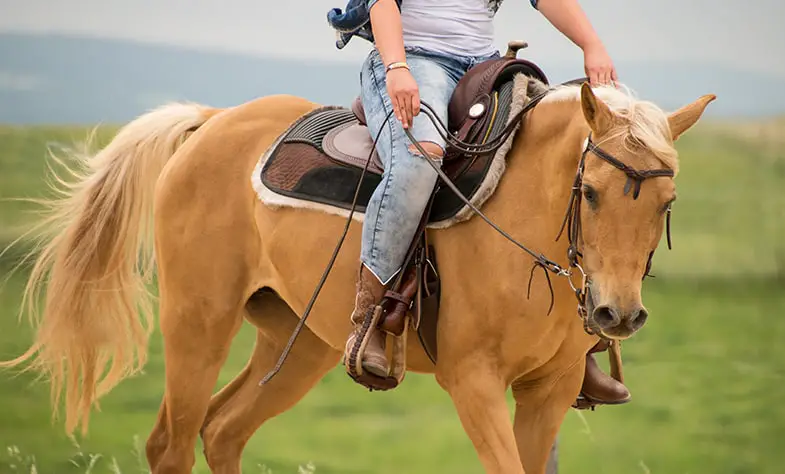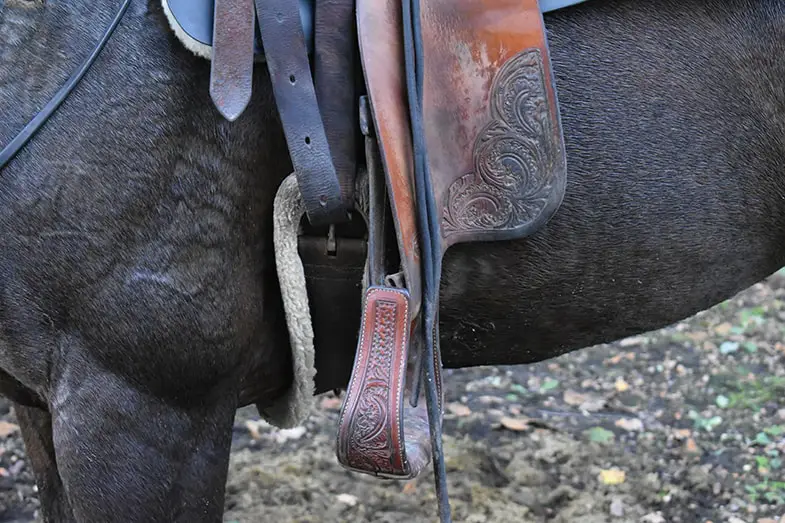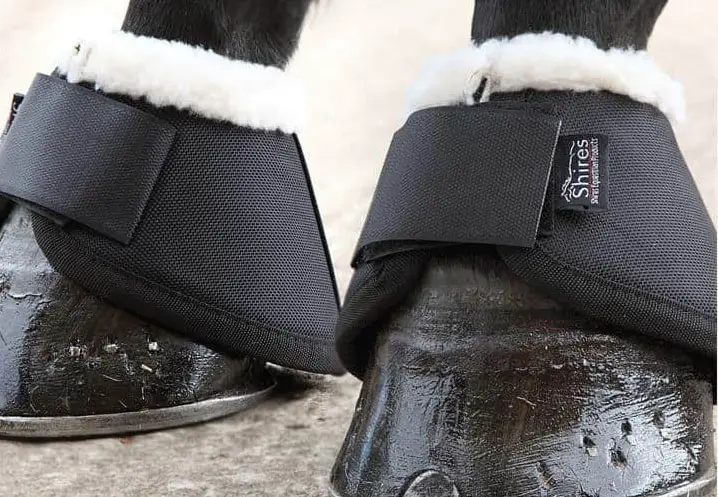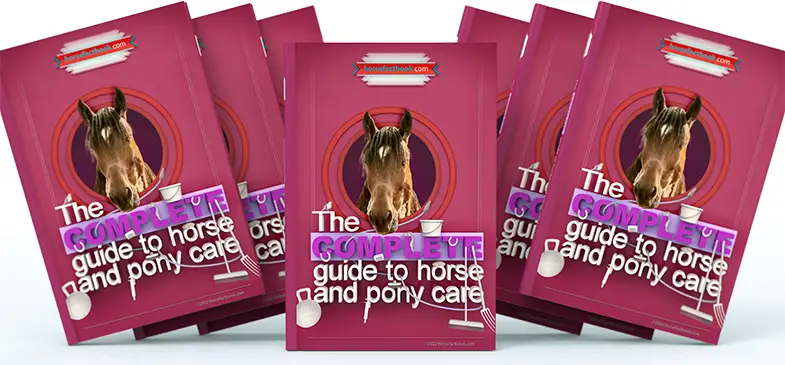If you’re new to horses or are considering buying your first horse it can be difficult to know what you’ll need and what you can live without, at least for the time being. While most horses are sold with halters and lead ropes you’ll need to buy a lot of other items yourself, especially riding tack (or saddlery as it’s sometimes called), which is why I decided to write this article. I’ve known way too many people who have rushed out to buy everything only to find that they don’t need half of it and some items aren’t even suitable for their horse, so wanted to pass on what I’ve learned over the decades of horse ownership.
What tack does a horse need? All horses need a halter and leap rope, regardless of whether or not they’re going to be ridden. Riding horses will also need a bridle, including a bit and reins as well as a saddle with cinch or girth and stirrups. Leg bandages and protective boots are also recommended although aren’t essential.
If you’re buying tack for the first time it can be an overwhelming experience with a seemingly infinite selection to choose from which is why it’s important to have a bit of knowledge beforehand, that way you’ll know what you’re buying and why you need it.
What is horse tack?
Horse tack is generally considered to be everything you need to ride a horse but it does also include halters and lead ropes, although some people also include blankets when they talk about tack. There are some people who refer to tack as being anything (and everything) used to care for a horse, and as such includes buckets, grooming kits, and even first aid kits. Personally, I always think tack refers solely to everything a horse needs for riding, I don’t believe a riding helmet, body protector, etc should be referred to as tack either.
Why is horse tack called tack?
While the word tack may seem like a strange and random word to describe all items of saddlery it’s actually a shortened version of tackle. Okay, so I admit that can sound strange too but it’s derived from when horses were used for agricultural work and had to be fitted with a whole load of tackle before they could start work.
Today it’s used in its shortened form and is now a general term used to describe all items of equipment (typically saddlery) that are used to ride, train and even handle horses. Some people also refer to items used in a horse’s daily care as tack too which is why buckets, blankets, and even first aid kits are sometimes referred to as tack.
Why is horse tack so important?
You might think that horse riding tack isn’t that important but it can help you to maintain your seat correctly which will help you to keep your balance, something the horse will definitely be grateful for. As well as helping with your seat the tack will allow you to control the horse, although this doesn’t need to be done from the saddle. The right tack will allow you to control the horse when leading them, riding, or even when training them.
Not only is horse tack important but it’s also crucial you get the right tack for your horse and that it fits him properly. Using tack that doesn’t fit properly can seriously hurt and harm the horse and can even cause them to suffer a great deal of pain ad distress. It can also lead to behavioral issues as the horse is trying to tell you something is wrong.
What type of tack does a horse need?
Each sport or discipline seems to have its own type of tack but if you’re not looking to compete or don’t know what discipline you want to partake in (or just prefer to ride for pleasure) then ‘general purpose’ or GP tack is perfect for you. The only thing you need to know is what style of riding you want to do, Western or English? If you’re not sure which one is best for you then you can read more about the differences (and similarities) between Western and English riding in my recent article.
It’s also worth mentioning that with the exception of bits, reins, and boots most Western and English tack isn’t interchangeable. A Western cinch will never work with an English saddle nor will an English girth work with a Western saddle. The same can be said for things like stirrups and fenders or stirrup leathers. Interestingly though, both styles of tack serve the same purpose and can, to some extent be used for both styles of riding. That said though you’ll never want to use a Western saddle for jumping, nor would you want to use a dressage saddle for roping.
What tack does a horse need?
People often get carried away with buying everything they think their horse may need (but probably never will) but as long as you have the basics you won’t need anything else unless you’re planning on competing or taking part in specialized events. Basic horse tack should include a saddle (including stirrups, saddle blanket, and a cinch or girth), bridle, bit, and reins as well as boots (both overreach and exercise boots or bandages).
Halter (and lead rope)
Even if you never intend to ride your horse you’ll still need a halter and lead rope. They go over the horse’s head and are used for leading them around but can also be used for training. Both halters and lead ropes can be made from a variety of different materials such as nylon webbing, leather, and even rope. Some also have sheepskin padding too.
Different companies have different sizes but they’re generally found in foal, pony, cob, horse, and oversized or draft size.
If you want to know more about halters and how to choose the right one then you should read my recent article on the subject (although don’t read it until you’ve finished this one 😀)
Bridle or hackamore (or bosal)
Like a halter, the bridle goes over a horse’s head but unlike the halter, it’s used for riding, although it can also be used when training a horse. The bridle is made up of a headpiece (or headstall) to which other straps (namely the browband, cheek strap, throat lash, and noseband (which is optional)) are attached. The bit is attached to the cheek strap and the reins are fastened to the bit.
When fitted properly the bridle, along with the bit apply pressure to the horse’s mouth and poll and allow the rider to control the horse’s speed and direction.
The hackamore, on the other hand, is similar to the bridle but doesn’t have a bit and is sometimes referred to as a bitless bridle. Unlike the bridle though it doesn’t have a throat lash but does always have a noseband. It’s very popular in Western disciplines and for training but is becoming more popular in English disciplines too.
The hackamore applies pressure across the horse’s nose instead of to the horse’s mouth.
Bit
Sitting in the horse’s mouth, the bit is typically attached to the cheek strap of the bridle and acts as a way for the rider, via the reins, to control the horse ad give the horse suitable commands about speed and direction.
There’s a huge range of bits available but they all fit into one of three different groups, snaffle, curb, and combination. A snaffle is the gentlest of bits and applies pressure to the horse’s mouth while the curb bit applies pressure to the horse’s poll, cheeks, and chin as well as the mouth. The combination bit (sometimes called a Pelham), on the other hand, is normally a two bit set that has both a snaffle and curb bit. They’re also often used with double reins too.
As a general rule, you should always go for the softest and most gentle bit you can. Unless you know your horse needs a particular bit you should start with a snaffle, you can always change it later if you feel your horse needs something different or if you’re intending to compete.
If you want to know more about the different types of bits and mouthpieces (the part of the bit that actually goes in the horse’s mouth) and what they’re used for here.
Check out this article if you want to know more: Everything you need to know about bits and mouthpieces
Reins
Many new riders think that the reins are there to act as a handle to keep them in the saddle but this isn’t the case at all. Instead, the reins, which are attached directly to the bit (or the hackamore), are your main form of contact with the horse.
Regardless of riding style, reins can be found in a range of materials such as leather, rope, rubber, and even synthetic. You also have a choice of size as well as whether or not you want the reins to be split (best for Western), closed (more popular with English), or double (used with combination bits).
Saddle
The saddle is one item of tack that everybody, regardless of whether they’re horsey people or not, recognizes so I’m sure I don’t need to tell you that it sits on the horse’s back and is used to evenly distribute the rider’s weight over the horse’s back. It also helps the rider to maintain the correct riding position.
Like bridles and halters, saddles can be made of leather or man-made synthetic materials, but they can also be rigid (which means they have a fixed structure known as a tree) or flexible (often referred to as treeless). That said, if you’re a new or inexperienced rider you should opt for a treed saddle.
While there are dozens of different styles of saddle out there for different disciplines there are only two main types of saddle, Western and English. They both serve the same purpose but are very different in appearance.
Whatever style of saddle you go for it’s crucially important that you get the right one for your horse. A poorly fitted saddle can cause all manor of problems for the horse. Ultimately resulting in permanent damage if the issue isn’t addressed.
It’s also worth pointing out that unless you’re buying a horse that comes with a saddle it’s best to wait until the horse arrives before you buy the saddle. This way you can make sure it fits the horse properly and even, if possible, try a few saddles out before settling on one of them.
Stirrups
Stirrups are the ‘cups’ you put your feet in to help you keep your legs in the correct position, but they also help you to stay in the saddle and maintain your balance.
A lot of saddles, both Western ad English, come with stirrups but if not then I’d advise you to get a set of safety (or quick release) stirrups. They often look the same as ‘normal’ stirrups but have the added bonus of quickly releasing your foot if you should fall.
Cinch or girth
Like stirrups, a lot of saddles come with cinches (for Western saddles) or girths (for English saddles) so you generally don’t need to worry about this. If you have a Western saddle you can also use a rear cinch that does up just past the horse’s belly and stops the saddle from moving forward if you’re going downhill.
Saddle blanket/saddle pad
Saddle blankets and pads are more or less the same thing, Western riders refer to them as saddle blankets while English riders call them saddle pads. English saddles can also have a pad that’s the same shape as the saddle and these are referred to as numnahs. Whichever one you choose the idea is that they provide cushioning to the horse and prevent the saddle from chafing or rubbing his back. It can also protect the saddle from sweat.
It’s also worth pointing out that the blanket should only be used for its intended use and not to compensate for a poorly fitted saddle.
Exercise bandages
While they’re not really essential, exercise bandages (or boots) will help to protect the horse’s legs from scrapes and injuries as well as from bruising which is often caused when the horse’s legs rub together as they move. Exercise bandages or boots will also support the tendons and ligaments in the legs too.
If you’re not sure how to use exercise bandages then you’ll find this article helpful.
Overreach boots
Like exercise bandages, overreach boots (or bell boots as they’re also known) aren’t essential but could help prevent cuts, scrapes, and other injuries. They fit around the horse’s front ankles and cover their hooves, the idea is that if the horse overreaches with his hind legs (ie he steps into the space occupied by his front legs), his front feet, fetlocks, and lower legs will be protected.
Breast collar / breastplate
The breastplate and breast collar are effectively the same thing and work in the same way. The breastplate is generally used in Western riding for things like trail riding where the horse is traveling up and down slopes a lot. The breast collar, on the other hand, is more common in English disciplines such as jumping and eventing.
As I say though they both serve the same purpose and that is to stop the saddle from slipping backward as the horse travels uphill or is rising up over a jump or obstacle.
Crupper
Not as common as a breastplate or collar, the crupper works in the opposite way in so much as it stops the saddle from moving forward when the horse is going downhill. It’s essentially a strap that goes underneath the horse’s tail and attaches to the back of the saddle.
Tie-down or martingale
While you shouldn’t use a tie-down or martingale if you’re inexperienced I thought it was worth mentioning it, if nothing else it’s often seen in disciplines such as barrel racing, roping, show jumping, or eventing.
The purpose of a tie-down (which is used in Western riding) or a martingale (which is popular in English disciplines) is to prevent the horse from raising its head. The tie-down is also used in high-speed disciplines to help the horse maintain their balance during tight turns and fast maneuvers.
Saddle rack
Okay, so I admit that it’s not really an item of tack but you’ll need somewhere to keep your saddle when you’re not using it. If you’ve got a portable saddle rack you can also use it to put the saddle on when you’re cleaning it.
Takeaway message
While it’s easy to get carried away with all of the different options on the market today it’s important to keep in mind what your horse needs as well as what sort of riding you’ll be doing. My advice would be to start with the basics, you can always buy other things at a later date.
If you’re new to the world of horse ownership (or will soon be) then first of all let me congratulate you, owning a horse is a wonderful thing and I’m sure the two of you will have many great memories together. Secondly let me tell you about my latest digital book, The Ultimate Guide To Horse & Pony Care. I wrote it specifically for new owners and it covers everything you need to know about owning, feeding, and caring for your new horse in general. To bag your copy for just $7.99 click here, or below, to order your copy today.
Related questions
When was horse tack first used?
The first horse tack ever discovered dates to around 2000 to 1500 BC and was nothing more than a very crude bridle that was used to steer the horse. It wasn’t until 700 BC when the saddle was believed to have been invented, although at the time it was nothing more than a cloth pad. It was around 206 BC when the saddle as we know it today was first developed.
Can you ride a horse without any tack?
If the horse is exceptionally well trained and you’re experienced enough to be able to control the horse with just your legs and body (and of course voice) then yes, it’s possible to ride a horse without any tack. Nine times out of ten though this won’t be the case and you’ll need some tack for riding.
If your balance and riding position are both good then you can ride without a saddle but you’ll still need some way of controlling the horse so I wouldn’t recommend riding without a bridle.
I hope you found this article helpful. If you did I’d be grateful if you could share it please as it would really help me.
Recommended products
Over the years I have tried hundreds of different horsey products, from various blankets and halters to different treats. Some I’ve loved, others I’ve hated but I thought I’d share with you my top all-time favorite products, the ones I never leave the yard without. I’ve included links to the products (which are in no particular order) that I really think are great.
- Horse Knots by Reference Ready – If you’re like me and enjoy pocket reference guides then you’ll love this knot tying guide. These handy cards can easily fit in your pocket or attach to the saddle for quick reference. They’re waterproof, durable and are color coded to make them easy to follow.
- Mane ’n Tail Detangler – Even if you never show your horse you’ll need to detangle his tail from time to time (and possibly his mane too) which is always a challenging chore! I’ve found that if I run a little bit of detangler through my horse’s tails every few days it stops them from getting matted up and makes combing them easy, even if they’re coated in mud. I don’t know if I should admit to this or not but it also works wonders on my hair.
- TAKEKIT Pro clippers – Over the years I’ve tried a lot of different clippers and while some were obviously better than others I found these to be by far the best. They are heavier than a lot of other clippers but for me, that’s a good thing, it makes them feel more sturdy and hardwearing. On top of that they have a range of speeds so are just as good for clipping your horse’s back as they are his face. I also like the fact that they come in a handy carry case but that’s not for everybody. The company that makes them is super good and incredibly helpful too, a real bonus these days. The only thing I wasn’t keen on was the fact that it doesn’t come with any oil, but that’s not a major problem as it’s not difficult to buy lubricant.
- Shire’s ball feeder – There are so many boredom buster toys out there but I like to use these every day, regardless of whether or not my horses are bored. I find that it helps to encourage my horses to problem solve by rewarding them with treats (or pieces of fruit) but it also mimics their natural grazing behavior which helps to keep them calm and de-stressed.
- Horse safe mirror – This is a strange one that many people are surprised about but I like to put horse safe mirrors in the trailers as well as in the quarantine stalls. It helps to prevent the feeling of isolation by giving the impression of other horses being around. Being herd animals horses can get extremely stressed when they feel that they’re on their own but with these stick-on mirrors, they believe that at least one other horse is with them.
- Rectal thermometer – I know this isn’t glamourous at all but it’s vital for your horse’s well-being to be able to check their temperature and a rectal thermometer is the easiest way of doing this which is why I’ve added it to the list.
Shopping lists
I’ve also put together a few shopping lists of essential items that I’ve found helpful over the years. I’ve broken the lists down into different categories rather than put everything in one massive list 😉

